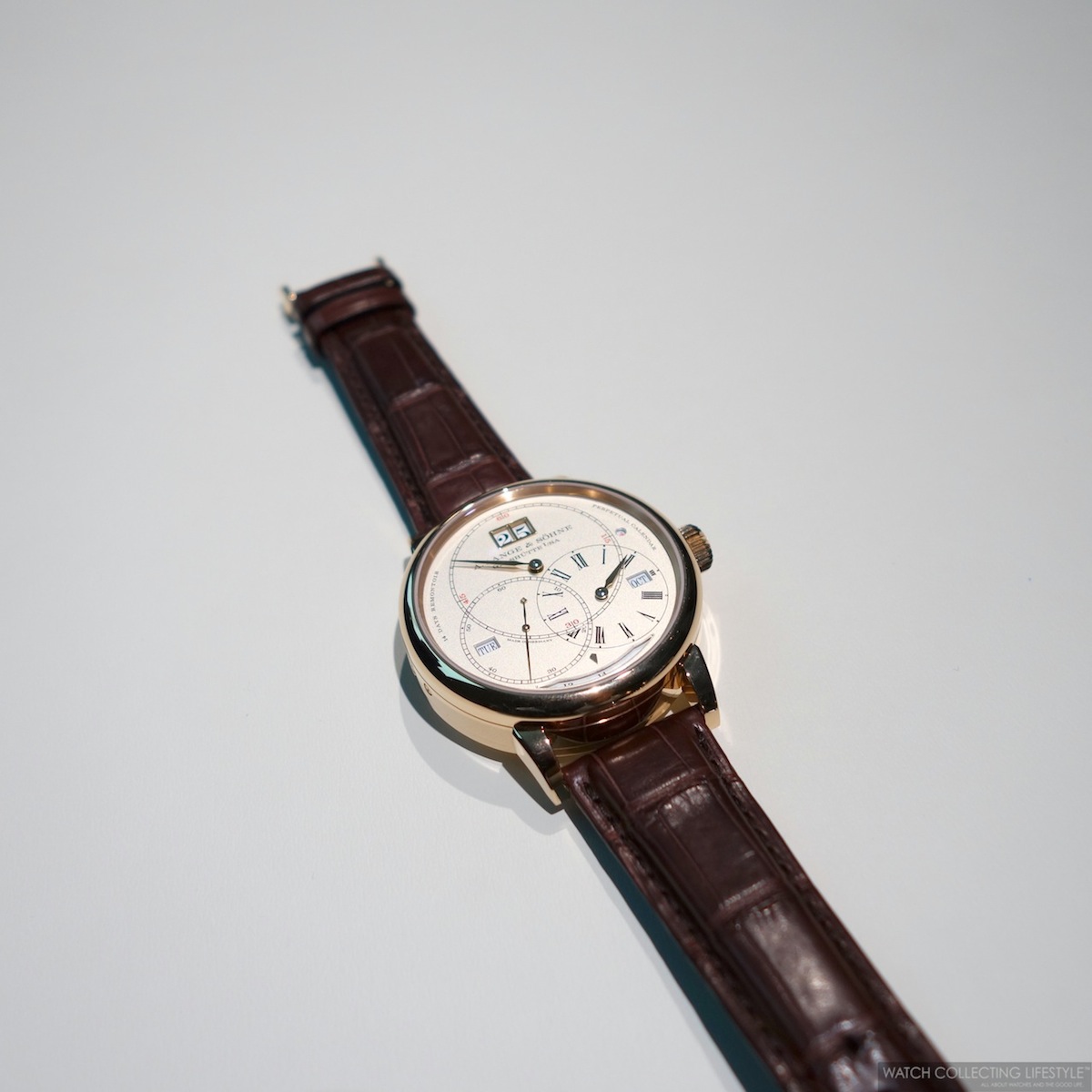A. Lange & Söhne wowed the industry with the unveiling of the horological masterpiece the Richard Lange Perpetual Calendar "Terraluna". This fascinating perpetual calendar aside of providing you with four precise jumping displays for the date, day, month and leap year, includes a patent pending orbital moon phase display, a constant force escapement that delivers accurate timekeeping with an outstanding power reserve of 14 days. The watch is available in 18K white gold or 18K pink gold is fitted with two sides equally impressive and very unique in terms of complication and functionality.
Fitted with a solid and robust case measuring 45.5 mm in diameter and 16.5 mm thick, the watch stands out with the regulator layout of scientific precision watches. The movement side presents an innovative and useful orbital moon-phase display that depicts the constellation of the earth, moon, and sun. The circles of the time indication and the perpetual calendar apertures characterize the design of this new watch. The large minute circle is at the top of the dial, while the smaller dials for the hours and seconds are beneath it, shifted toward the right and left.
As was already the case with the Richard Lange Tourbillon “Pour le Mérite” presented in 2011, this dial design was inspired by a great historic role model: Johann Heinrich Seyffert’s 1807 regulator from the world-famous timepiece collection of the Mathematics and Physics Salon. With his ingenious designs, Seyffert helped transform Dresden into a hub of precision horology in the early 19th century. A great advantage in precision pocket watches, the regulator format was appreciated not only by time-keeping services and observatories, but also by watchmaking manufactures where it was used for synchronizing new timepieces. This is because it provided an accurate display of the minutes and seconds.
Beneath the characteristic Lange outsize date —the first one in a model of the Richard Lange collection, incidentally— two smaller apertures show the day of the week on the left and the month on the right. Thanks to this arrangement, the calendar displays can be easily read at a glance. The calendar is mechanically programmed to correctly display the different durations of the months in a year as well as those in leap years until 2100. The leap-year indication is located in a small round window on the right-hand side of the 15 of the minute circle. All displays of the calendar switch forward instantaneously to assure unambiguous readings at all times. To keep the power for the switching process as low as possible, the required energy is gradually built up via a cam and then released abruptly at midnight.
An exciting technical innovation can be seen on the movement side: there, the patent-pending orbital moon-phase display shows the location of the moon relative to the earth and the sun – for the first time ever in a wristwatch. The display consists of three discs. On the star-studded celestial disc, the moon –visible through a round aperture– orbits around the earth anti-clockwise once a month. The mechanism reproduces the synodic month of 29 days, 12 hours, 44 minutes, and 3 seconds so precisely that it takes 1058 years before the display needs to be corrected by one day. Beneath it, the lunar disc rotates, featuring two round new moons. The progression of the moon phases can be observed through the aperture in the celestial disc. In the constellation view, the position of the sun is occupied by the balance. On new-moon days, the dark moon stands between the earth and the sun. It appears as a bright sphere on the opposite side of the earth on full-moon days. Thus, the position and phase of the moon are indicated simultaneously. In the center of the display, the earth rotates about its own axis once a day. It is daytime on the half that faces the sun, or the balance, and night-time on the other. The peripheral 24-hour scale provides a time-of-day reference for the northern hemisphere.
The ambitious precision goals of Lange’s product developers come to the fore not only in the configuration of the moon-phase display mechanism, which consists of three solid white-gold discs, but also in its design. To achieve a vivid and aesthetically sophisticated image of the orbiting moon-phase display, they chose a special coating process. On the celestial disc, for example, interference effects absorb all of the non-blue color spectra of the incident light. The result is a deep-blue surface studded with more than a thousand high-contrast, sharply contoured stars.
At the 6-o’clock position, a power-reserve indicator in the form of a circumferential ring tells the owner when the time has come to replenish the movement with fresh energy via the winding crown. The Lange manufacture manual wound calibre L096.1 is crafted to the most exacting Lange quality standards, decorated and assembled by hand; precision-adjusted in five positions with a twin mainspring barrel, constant-force escapement with remontoir spring produced in-house, a three-quarter plate made of untreated German silver and a balance cock engraved by hand. This fascinating calibre is composed of 787 parts, 80 jewels —one screwed in a gold chaton— and provides 336 hours of power reserve —14 days— when fully wound while beating at a frequency of 21,600 vph.
The 18K pink gold model ref. 180.032 is fitted with a hand-stitched reddish-brown crocodile strap with Lange deployant buckle, while the 18K white gold model ref. 180.026 comes with a black crocodile strap also with Lange deployant buckle.
Sticker Price 18K white gold 186,000 Euro and 18K pink gold 185,000 Euro.
For more info on A. Lange & Söhne SIHH 2014 Novelties click here.




























